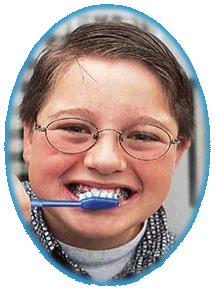Oral Hygiene
It's more important than ever to brush and floss regularly when you have braces, so the teeth and gums are healthy after orthodontic treatment. Teeth do not decay any more under braces than they do when the teeth are not being moved but it is necessary, however, to keep your teeth well brushed, especially after eating and most of all before you go to bed. Clean teeth and braces provide the best protection against damage to your teeth and are the best way to ensure a healthy smile! Food allowed to remain on teeth and in braces while you sleep can accumulate, and over time, turn into plaque. This will cause a weakening of the tooth enamel and may lead to gum disease, enamel stains and tooth decay. To avoid these problems while you are in orthodontic treatment, take special care of your braces, teeth and gums to ensure you will have the best possible result.
Individual instruction will be given at the start of everyone's treatment. Please inquire if you are not sure about the proper tooth brushing or flossing technique with braces. Be especially careful that the areas between the braces and gum tissues are shiny and clean. If you are unable to brush at school, brush after having a snack when you get home from school.
Brushing
Both cavities and gum disease are caused by slimy film we call plaque, which can accumulate on the teeth and gums. The plaque is made of millions of germs called bacteria. The plaque must be removed everyday to prevent cavities and decalcifications (stains) from developing around your braces.
This can be done best with the following proper brushing and flossing methods:
You must brush your teeth five times a day as follows:
- Immediately after breakfast.
- Immediately after lunch
- Immediately after school.
- Immediately after dinner.
- The very last thing before you go to bed at night.
We recommend a soft-bristle brush and a small strip of fluoride toothpaste.
When you brush your teeth, move the brush in small, circular motions to reach food particles that may be under your gum line. Concentrate on cleaning the edges of the gums. This is the most important area to keep clean so you can avoid cavities and puffy gums. Place the bristles on the tooth between the braces and gum and brush slowly and carefully, covering all areas between teeth, between braces and the surface of each tooth.
Now, thoroughly brush the chewing surfaces and tongue side of each tooth. Brush your tongue! The plaque also collects on your tongue and is the major cause of bad breath. Brushing your tongue will give you a fresher breath.
Proper brushing will take you 2-4 minutes to thoroughly brush your teeth, so donít rush it. Every time you brush you time yourself with a watch, clock, or timer to insure that you brush for at least a full two minutes each time.
Brush up on the lower teeth, down on the upper teeth and the outside, inside and chewing surface of your front and back teeth. The goal is to not miss any areas, so establish a pattern. After brushing, look into the mirror. If your teeth look dirty, brush again!
You will need to replace your toothbrush more often due to your appliances. As soon as the bristles start to wear down or fray, replace your toothbrush with a new one. It may be difficult for your toothbrush to reach some areas under your archwire.
Flossing
For areas between the teeth that a toothbrush canít reach, use dental floss to remove food particles and plaque. Flossing takes more time and patience when you are wearing braces, but it is important to floss your teeth every day.
Use the reusable floss threader provided by our office to floss under your archwire daily. Pull a small length of floss from the dispenser through the threader and slide it up and down along the side of each tooth. You will be able to feel when the tooth is clean and hear the squeak of the floss against your clean teeth. Use care around your archwire and do not floss too forcefully around it or put too much pressure on it. After you floss between your archwire and braces, floss between your other teeth and gums.
If you are flossing without the floss threader, pull a small length of floss from the dispenser. Wrap the ends of the floss tightly around your middle fingers. Guide the floss between all teeth to the gum line, pulling out food particles or plaque. Unwrap clean floss from around your fingers as you go, so that you have used the floss from beginning to end when you finish. Floss behind all of your back teeth.
Floss at night to make sure your teeth are clean before you go to bed. When you first begin flossing around your braces, your gums may bleed a little. If the bleeding does not go away after the first few times, inform a staff member at your next appointment.
Visiting the Dentist
During your orthodontics, we usually recommend 4 to 6-month intervals for cleanings, but your dentist will discuss with you what he or she feels is best. Keep in mind, patients who do not keep their teeth clean may require more frequent visits to the dentist for a professional cleaning.
Adults who have a history of gum disease should also see a periodontist during orthodontic treatment.
|
![]()
![]()
